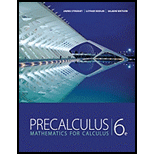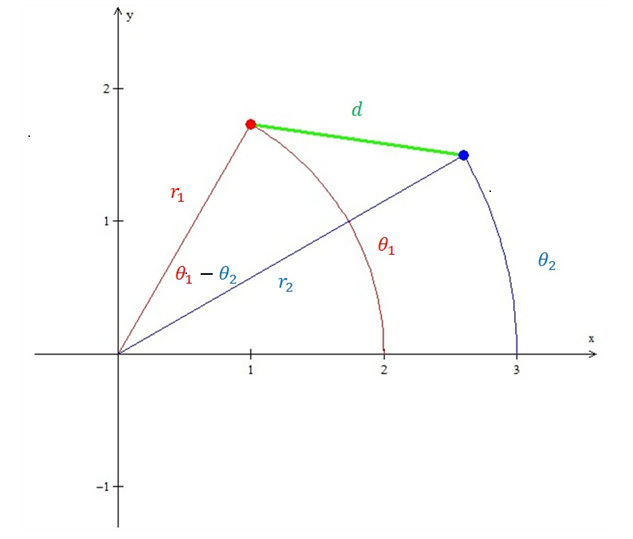
(a)
To prove: the distance between the polar points .
(a)
Answer to Problem 69E
Here, It is proved that the distance between the polar points
Explanation of Solution
Given:
Calculation:
Use the Law of Cosines to prove that the distance between the polar points
Let’s first make an example plot. Point
Each forms an angle with the positive

If connect the two points, form a triangle made of this segment and the two radii. The angle between the two radii is the difference of the two angles ,
Since two sides,
Note that because
This is the equation asked to prove at the beginning.
Conclusion:
Hence, It is proved that the distance between the polar points
(b)
To find: the distance between the points of the given polar coordinates
(b)
Answer to Problem 69E
Here, the distance between the points whose polar coordinates are
Explanation of Solution
Calculation:
Find the distance between the points whose polar coordinates are
Let’s make Point
The formula from part (a) states that the distance between two polar points is
Plug in the assigned values
It will actually be easier to find the value of the cosine if the cosine difference formula is used, which states that
So,
Place this value back into the distance formula.
This is the exact value of the distance between Points
Conclusion:
Hence, the distance between the points whose polar coordinates are
(c)
To convert: the points to rectangular coordinates and distance between them.
(c)
Answer to Problem 69E
Here, the decimal value is about
Explanation of Solution
Calculation:
Convert the two points from part (b) to regular coordinates, and then find the distance between them (using the regular rectangular formula).
Let’s start with Point
find the x- and y- coordinates by using two formulas relating polar and rectangular coordinates.
Point
Point
In rectangular coordinates.
Point
Point
In rectangular coordinates.
Let’s put in the coordinates found for the two points.
This expression can be further simplified, or just enter the entire expression into a calculator. If this is done, find that the decimal value is about
Conclusion:
Hence, the decimal value is about
Chapter 8 Solutions
Precalculus: Mathematics for Calculus - 6th Edition
 Calculus: Early TranscendentalsCalculusISBN:9781285741550Author:James StewartPublisher:Cengage Learning
Calculus: Early TranscendentalsCalculusISBN:9781285741550Author:James StewartPublisher:Cengage Learning Thomas' Calculus (14th Edition)CalculusISBN:9780134438986Author:Joel R. Hass, Christopher E. Heil, Maurice D. WeirPublisher:PEARSON
Thomas' Calculus (14th Edition)CalculusISBN:9780134438986Author:Joel R. Hass, Christopher E. Heil, Maurice D. WeirPublisher:PEARSON Calculus: Early Transcendentals (3rd Edition)CalculusISBN:9780134763644Author:William L. Briggs, Lyle Cochran, Bernard Gillett, Eric SchulzPublisher:PEARSON
Calculus: Early Transcendentals (3rd Edition)CalculusISBN:9780134763644Author:William L. Briggs, Lyle Cochran, Bernard Gillett, Eric SchulzPublisher:PEARSON Calculus: Early TranscendentalsCalculusISBN:9781319050740Author:Jon Rogawski, Colin Adams, Robert FranzosaPublisher:W. H. Freeman
Calculus: Early TranscendentalsCalculusISBN:9781319050740Author:Jon Rogawski, Colin Adams, Robert FranzosaPublisher:W. H. Freeman
 Calculus: Early Transcendental FunctionsCalculusISBN:9781337552516Author:Ron Larson, Bruce H. EdwardsPublisher:Cengage Learning
Calculus: Early Transcendental FunctionsCalculusISBN:9781337552516Author:Ron Larson, Bruce H. EdwardsPublisher:Cengage Learning





